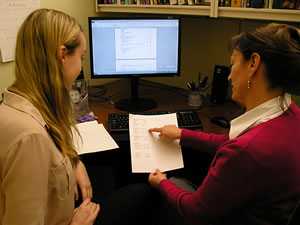CDC Women in STEM Careers - Laura Brown, PhD
Behavioral Scientist
National Center for Environmental Health, CDC

Math and science used to scare Laura Brown because they didn’t come naturally to her. She had always avoided them—until she needed them for her chosen career.
Of her career combination, she says, “The goal in both psychology and public health is to improve quality of life.”
One Class Changed Her Life
I remember sitting in a social psychology class in college learning about some classic experiments. I was fascinated by how much people’s thoughts, feelings, and behaviors are influenced by other people and the environment. The study designs also intrigued me. That course changed my life.
But I had to overcome a big hurdle when I found out I needed to take statistics and biology courses. That scared me. I was good at liberal arts, but I didn’t think I had a gift for math and science. Then I realized what I did know was how to study effectively. I felt empowered.
As long as I studied, I could master the material and succeed even in math and science. It was rewarding to see that when I worked at something I could tame the fear and excel. Surprisingly, I found I even liked those courses.
"I really like how data analysis answers questions for you. It can provide information that people are eager to get."
My PhD is in experimental psychology. I focused on how to design studies and measure behavior, as well as the effect that other people and the environment have on that behavior.
What Do Psychology and Public Health Have in Common?
Studying behavior improves public health. By understanding why people do what they do, we can help them make better choices.

Dr. Brown is working with Taylor Radke, a food safety research fellow, on analyzing data from a study on cross-contamination prevention practices.
I work on food safety studies at CDC. I work with a team to develop the studies, collect the data, and analyze the results. For a study we did on hand washing, our food safety experts watched food workers for an hour and noted every time they needed to wash their hands and whether they actually did or not.
We found food workers do nine activities an hour that require hand washing, but they only wash 30 percent of the time. This is a food safety risk. If food workers don’t wash their hands when they should, they can spread foodborne illness to customers.
We recommended that restaurant managers review food worker tasks with an eye toward reducing the number of times food workers needed to wash their hands. In another study, we investigated why workers show up when they are sick, especially when they have foodborne illness symptoms like vomiting and diarrhea. We found that many came in sick because they didn’t want to leave their coworkers short-staffed or because they had a strong work ethic and felt they should work no matter how sick they were.
Part of the fun of being a behavioral scientist is using data to explain a phenomenon and tell a story.
A Skill That Always Helps
When I began working at CDC, I didn’t have a food safety or public health background. So even though I had the research skills, I had to get up to speed on the content. That was challenging.
Once again, I used my “knowing how to study” skills that I had learned in college. Because I know how to learn, I applied those principles that had served me well in the past. While on the job, I became a self-taught student of food safety and public health.
Advice to Girls and Young Women
Learn how to study. You never know where that basic core skill can take you in life.
Top of Page- Page last reviewed: March 20, 2015
- Page last updated: March 20, 2015
- Content source:


 ShareCompartir
ShareCompartir